In this episode of the IDk 15-minute webinar series, CampusIDNews Publisher Chris Corum is joined by Rawldon Weekes, Campus Lead for reader and software developer ELATEC. The discussion focuses on how campuses can solve for all those "other" one-off and unique applications that need the campus card or mobile credential to function.
When a campus migrates to a new ID technology is when all the under-the-radar use cases for the card surface. A move to contactless and mobile credential is no exception. Campuses tend to focus on access control, payments, and mealplans, but one-off applications created by departments and other entities go unnoticed. That is until they stop working.
USB readers can pull data from contactless cards and mobile credentials and present it in the format needed for unique, specific applications
How can we support these legacy applications and enable our contactless or mobile credential to power new applications from scooter rentals to lockers and printing to computer access?
Many campuses have found the solution using ELATEC's USB readers to pull data from contactless cards and mobile credentials and present it in the format needed for specific applications. ELATEC readers support access control and payment functions, but they also are ideal for the unique, one-off use cases campuses struggle to support.
Join us as we learn about something IDk.
Click on the image at the top of this page to check out the video.
Electronic lockers are coming to campus, and they are seeing a growing number of use cases. For years higher ed has used lockers to automate mailroom parcel delivery, but today these advanced lockers are loaning laptops in libraries, keeping food warm in dining pickup locations, and more. Campus cards and mobile devices control the check-out/check-in process in a convenient and secure manner. In this edition of CampusIDChats, publisher Chris Corum gets the lowdown, talking with Jessica Martinez from locker provider Luxer One and Assa Abloy's Tyler Webb.
Lockers are a way to securely exchange goods on campus, whether those be parcels, food, laptops, lab equipment, or convenience items.
Sample use cases include:
Check out the interview and product demo by clicking on the video at the top of this page.
At the beginning of 2023, Penn State rolled out Transact Mobile Credential to students, faculty, and staff. Among mobile credential programs, this one stands out because it was rolled out simultaneously across all 24 campuses of Penn State. In partnership with Transact, the campus team faced a unique set of challenges presented by this geographically and administratively dispersed project.
The move to mobile has been on the institution’s roadmap for nearly a decade, but it was completed in a short timeframe when the work commenced.
“It started with a vision to improve security and have every part of Penn State across the Commonwealth offer a seamless digital campus experience,” says Mike Sherlock, director of information technology, Penn State Auxiliary and Business Services. “The project officially launched in early spring of 2022, with students beginning mobile provisioning in January 2023.”
We provisioned 14% of students on day one across 24 campuses and today 81% of students at Penn State have provisioned the mobile id+ card
Like most campuses transitioning to mobile, Penn State had a portion of the necessary reader infrastructure already in place. Still, in a system that supports 88,000 students on campuses throughout the state, there were a massive number of transaction points to enable.
“We started moving toward contactless, mobile-enabled readers during the pandemic,” explains Sherlock. “However, the bulk of the nearly 2,000 door, food service, vending, laundry, and off-campus program readers were replaced in the summer of 2022. We continue to upgrade readers across the Commonwealth, hoping to be mostly complete by 2025.”
Campus staff managed the coordination and installation of the reader infrastructure, while Transact assisted with IT support, marketing, and project management.
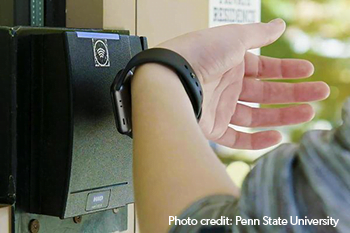 Launching midway through the academic year meant that students activating the mobile credential would opt to do so without guidance and instruction from a new student orientation process. For this to be successful, a strong marketing campaign was essential.
Launching midway through the academic year meant that students activating the mobile credential would opt to do so without guidance and instruction from a new student orientation process. For this to be successful, a strong marketing campaign was essential.
Transact’s engagement marketing team and Penn State’s Auxiliary and Business Services marketing and communications team worked together to develop the campaign.
According to Sherlock, Penn State saw a record-setting launch for the mobile id+ card. “We provisioned 14% of students on day one across 24 campuses,” he says. More than 25,000 individuals had activated the mobile id+ card by the close of the spring semester, and as of September 7, 2023, 81% of students at University Park and the Commonwealth Campuses of Penn State have provisioned the mobile id+ card.
As part of the longstanding roadmap, Penn State has embraced a mobile-first vision for the campus card and door access. Still, major projects like mobile id+ often require a transitional phase.
“Physical cards will remain necessary in the short-term, as access to (some) facilities and resources may still require the physical campus card until all readers are replaced,” says Sherlock. “Our goal is to use mobile as our primary method of payment and entry access before 2025.”
Deploying mobile credentials across multiple, disparate campuses creates challenges, even beyond a traditional migration.
“One of the critical challenges is the cost-sharing and logistics of replacing the current legacy card-swipe technologies with the updated reader hardware across University Park and all Commonwealth Campuses,” says Sherlock.
He advises other campuses embarking on this journey to remain flexible. “Each demographic connects to an institution differently,” he concludes. “We did a good amount of research and benchmarking before our launch and learned from all the schools and institutions that have gone before us.”
From Transact’s perspective, they were happy to share their experience to help make the Penn State project a success.
"Transact leads the way in providing a smart, mobile-centric student experience with a client-focused approach and innovative technology," says Rasheed Behrooznia, SVP and GM, of Campus ID Solutions. "This commitment to client satisfaction and future-thinking sets us apart, and we are proud to work with Penn State on a shared mission to revolutionize campus life.”
To hear firsthand about Penn State’s successful rollout, register for the webinar below:
Penn State’s unparalleled mobile id+ card launch
Thursday, November 9, 1 PM EST
At the start of the fall term in 2022, the Sheridan College onecard office rolled out its new Mobile onecard. The Canadian institution serves 27,000 students across its three campuses in Ontario, so launching a project of this magnitude required careful planning and a well-orchestrated marketing effort to ensure success. CampusIDNews spoke with Aesha Brown, Sheridan’s onecard Manager to learn about the project and her advice for other campuses considering a transition to mobile credentials.
CampusIDNews: How long was mobile on the roadmap for Sheridan?
Brown: This was a 3-year long journey. We started to put together a business plan in 2020 and went to RFP later that year. We elected to stay with our current provider TouchNet and partnered with them on our mobile program. We went live with our mobile onecard for students with iOS devices on Aug 29, 2022, and then exactly one year later on Aug 29, 2023 we went live with our mobile onecard for students with Android devices. We planned this project as a phased approach.
The first few weeks in September our office usually has long lines for those wanting to obtain a plastic card, but this September we saw those lines cut in half
CampusIDNews: Can the mobile credential be used everywhere the plastic card can be used?
Brown: Yes, this was important to us because we wanted a positive student experience that mimicked the plastic onecard experience but with greater convenience. Our goal is to embed onecard into everything our students do here at Sheridan with ease.

CampusIDNews: How did the move to mobile impact your card reader infrastructure?
Brown: We overhauled our entire card reader infrastructure during this project in early 2022. Rather than perform a manual upgrade on the readers, either by doing it ourselves or shipping a batch of readers on a rotating basis back to HID, we decided to just replace all the door readers. This was decided (for a variety of reasons): long shipping times of the readers back and forth to Canada and the US; doors being left without readers for too long; and manually upgrading readers ourselves would have been impossible due to the various models of readers on campus.
Approximately 1300 new door readers were replaced by a third-party contractor across three campuses within three weeks. During testing there were challenges that occurred with the performances of a few of the door readers due to the age of the buildings and lack of wiring in some locations. We were able to resolve this by changing the wiring behind some of the walls and once that was completed, we were able to re-install the remaining door readers. Overall, the time involved to get all the readers installed and the re-wiring work done took two to three months.
CampusIDNews: What role did TouchNet play in delivering the solution to campus?
Brown: TouchNet played a vital role by providing their expertise in project planning, implementation and marketing for the mobile onecard project. TouchNet has rolled out similar projects with other institutions in the US so they already had experience. The most valuable aspect of our partnership with TouchNet is that they listened to our needs and made changes to the platform to ensure the success of this project.

CampusIDNews: How do you handle provisioning of the mobile credentials?
Brown: We provision through the TouchNet 360U mobile app. Continuous improvement from the TouchNet team has made provisioning in the app much simpler. At first there were several steps needed to provision the mobile credential, but TouchNet has streamlined the platform and our students have been very happy with the change.
CampusIDNews: How did you get buy-in from the students and the campus community?
Brown: I quickly realized that not only is this project “tech heavy” it is also a large change management project. It required many layers of effective communication to the entire Sheridan community. Our onecard touches so many areas on campus, and the project could not be done in isolation. I engaged with our marketing and communications specialists at the College and we took a pan-institutional approach to ensure our marketing campaigns and communications strategy were intentional and effective.
CampusIDNews: Walk us through the process of how a student obtains their mobile credential.
Brown: Once a student is accepted at Sheridan College, they receive a welcome email from the onecard office – usually in July for a September start date – inviting them to upload a photo. Once the photo has been approved, we send students an email with a link that provides all the information they need to obtain a mobile credential. This has worked really well as students can obtain the credential before they come to campus.
The first few weeks in September our office usually has long lines for those wanting to obtain a plastic card, but this September we saw those lines cut in half and our adoption rates for the mobile onecard increase substantially.

CampusIDNews: How about plastic cards and fees?
Brown: For now, we still offer plastic onecards at no charge for those that want one. We do not charge a fee for the mobile credential, contractually it is not allowed.
A day in the life of a typical college student involves an array of transactions, each relying on the campus credential. The student may:
In a recent article by Fred Emery, Senior Business Development Manager at TouchNet, he explains that this type of “transactional ease” requires a coordinated, integrated technology strategy between the card office, campus vendors, and the institution's student information system.
This level of transactional ease takes strategic planning and effort, and our campus card and transaction systems are central to it all
He outlines eight ways that an integrated card system streamlines operations and delivers significant benefits to the institution.
One key way is the system’s collection of actionable data.
“Connecting campus card technology to the student record system captures real-time data … that helps administrators improve student support and services,” he explains. “For example, using it to better schedule staff or optimize food preparation for peak times in the dining hall leads to improved student and guest experiences, reduced waste, and a better allocation of resources on campus.”
Improved efficiency is another key benefit.
Campus administrators are pulled in many directions and don’t have time to jump back and forth between multiple systems. An integrated campus ID system eases administrative tasks, centralizes reconciliation, and enables a single reporting source.
“Additionally, integration to the student information system can increase efficiency through automated data exchange, removing the need for many manual processes such as posting general ledger information or updating student accounts,” says Emery.
This level of transactional ease takes strategic planning and effort, and our campus card and transaction systems are central to it all.
To explore the other six benefits and consider how you can use them to promote your program to senior leadership and other on-campus entities, read Eight Advantages of an Integrated Campus ID.
Recent studies show a significant spike in anxiety, depression, and suicidal ideation among college students. In the 2020-2021 academic year, more than 60% of students met the criteria for at least one mental health condition.
Webinar: Transact + Talkiatry = accessible mental health services for students
Tuesday, September 19 at 1 pm EST
A Transact-sponsored webinar will explore how its new partnership with psychiatric care provider Talkiatry is working to address the escalating mental health crisis on college campuses.
The partnership gives students access to mental health services via the Transact eAccounts app students already use for an array of campus services and transactions.
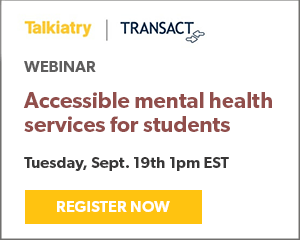
Talkiatry uses virtual care to eliminate barriers to access. Its services are covered by more than 60 health insurance plans and provided by a team of more than 300 psychiatrists specializing in treating mental health conditions including anxiety, depression, PTSD, and more.
“With so many college students struggling with everything from loneliness and low self-esteem to depression and trauma from sexual assault, it’s vital school administrators have access to the resources to help (students) stay in school and successfully manage their mental health,” says Robert Krayn, co-founder and CEO, Talkiatry.
“Improving student mental health is a topic we are passionate about at Transact,” explains Nancy Langer, CEO of Transact. “By incorporating Talkiatry’s resources into our products, we’re empowering millions of students and families with the tools needed to manage mental health effectively.”
Join Transact Campus CEO Nancy Langer and Talkiatry co-founders Robert Krayn and Georgia Gaveras on Tuesday, September 19 at 1 pm EST.
At a convenience store at Loyola University of Maryland, students are grabbing items and walking out of the store without checking out, scanning items at a POS, or seeing a cashier. Using Grubhub and Amazon’s Just Walk Out technologies, artificial intelligence, computer vision, and advanced sensors make it possible. The integration between the Grubhub app, already a fixture with Loyola students, and the Just Walk Out system is delivering a seamless and convenient solution for both students and operators.
Lyle Margerum, Director of Technical Operations, Grubhub Campus was on site at Loyola for the launch when we caught up with him to learn about this project and what it means to campuses across the country.
CampusIDNews: Thanks for taking time out from the events on campus. Can you tell me about the integration?
Grubhub: We have been talking with campus partners autonomous convenience stores for years. It is a challenging area to streamline with technology because it has always required cashiers. Just Walk Out provided an ideal the solution.
Early this summer we started doing the work with Amazon, and this week we delivered the first production orders.
Just Walk Out increases sales and brings value to students and the Loyola community. And it does it without the need to staff the location.
CampusIDNews: How does it work with Grubhub?
Grubhub: It is part of the normal Grubhub mobile ordering process. Just Walk Out appears as would any other on-campus dining location – say Chik-fil-a or a dining hall. The difference is that when you select Just Walk Out, there are no menu items to choose from within the app. They are going to choose their items when they enter the store. The user selects the payment method, and a QR code appears on the app’s screen.
The QR code is presented to the Amazon gate at the store, the light turns green, and the gate opens. Sensors and cameras determine which items are selected from the store shelves and track any unwanted items returned to a shelf. When shopping is complete, the user simply walks out the door. The transaction amount is charged to the meal plan account or selected payment method.
Before granting entry to the store, the system determines that there are sufficient funds in the campus account to enable a viable transaction. The Idea is to restrict a user with an ultra-low balance from overdrawing their account. If that does happen, the system could charge against a different tender or provide a report to the store operator to allow another collection process.
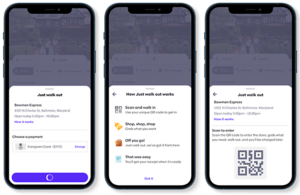
CampusIDNews: How did Loyola University of Maryland become your first partner for the new technology?
Grubhub: Loyola has been our partner since 2015, so we are leveraging a longtime partnership. They have been innovators on mobile ordering, kiosks, and other services for many years. Additionally, they have been talking with amazon and worked proactively to get this done.
Though they do have a transaction system provider, they did not want to introduce a secondary app just to support the identification of the student to the Just Walk Out system. Because the Grubhub app was already an integral part of campus life it made sense, and this integration just enhances our relationship with the student population.
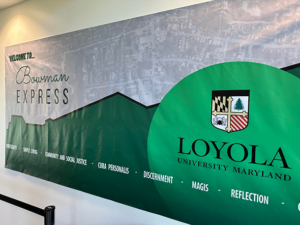 CampusIDNews: Tell me about the rollout at Loyola.
CampusIDNews: Tell me about the rollout at Loyola.
Grubhub: I have been on campus this week for the launch, and it has been great. Loyola is already talking about future locations. The initial location is a convenience store operated by the campus dining provider Parkhurst. It is located in the bottom of one of the residential halls.
It offers the campus 24x7 retail availability that was not feasible in the past. Students have access to food and drinks, laundry detergent, and a range of other needed items right where they live. This increases sales and brings value to students and the Loyola community. And it does it without the need to staff the location.
CampusIDNews: What do you see for the future of Grubhub and Amazon’s Just Walk Out?
Grubhub: With our integration with Amazon in place, adding other campuses will be incrementally easier. We have ironed out kinks in the experience which will expedite both the planning and rollout process. Our second campus will launch in the next couple of weeks at Montclair University, and others are already scheduled for later in the Fall and Spring semesters.
For Grubhub, it deepens our value proposition with our partner institutions. We now cover the full range of a campus’ needs – mobile ordering, kiosks, POS, robot delivery, reusable container solutions, lockers – and now cashier-less retail.
Students at the University of Kentucky community can now use their WildCard Mobile ID on an iPhone, Apple Watch or Android device to access campus buildings, make purchases and more. Transaction system provider CBORD and access control partner HID Global worked with the campus to make the new system a reality.
Students download the Mobile ID from the App Store or Google Play using through the campus-branded CBORD GET app. Using the app they can download the mobile credential directly to their smartphone or watch.
“CBORD worked with the University of Kentucky to develop a plan to support mobile credentials throughout the WildCard program,” says Read Winkelman, Vice President, Sales, CBORD. “The university now joins many CBORD campuses already using mobile credentials successfully.”
Already, more than 100 institutions are embracing mobile credentials and this adoption will grow exponentially every year.
“We have supported NFC-based mobile credentials since 2012, and our customers process over 350,000 mobile credential transactions daily,” Winkelman adds. “With our partnership, customers see industry-leading rates of student adoption, which speaks to our ability to simplify the move for a seamless launch.”
Physical security is a key application for the university. The campus community relies on access control solutions from HID Global across campus administrative buildings, classrooms and residence halls.
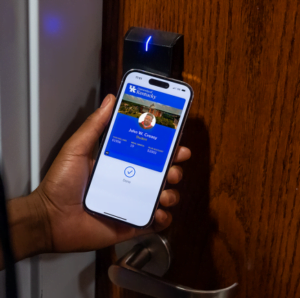
“We are proud to partner with the University of Kentucky on the rollout of mobile credentials,” says Tim Nybolm, Director – End User Business Development, Higher Education, HID Global.
“Today’s student is ‘born digital’ and is looking for a convenient and exceptional user experience,” he adds. “With the use of mobile credentials, students have found a more convenient, efficient and secure way to access buildings and amenities on campus.”
Nyblom told CampusIDNews that Kentucky and many other campuses have embarked on a digital transformation journey using mobile technologies to elevate the student experience and increase security. He says, “already, more than 100 institutions are embracing mobile credentials and this adoption will grow exponentially every year.”
While student love the idea of mobile ID, some concerns always exist. What if I lose my phone? How do I get into my dorm if my battery dies?
Modern mobile ID solutions put these concerns to rest.
If a student misplaces their iPhone or Apple Watch, they can use the “Find My” app to lock and locate the device. Using Apple Wallet’s Express Mode, the mobile ID can be used without unlocking or waking the device. Even if the phone’s power is depleted, reserve power still enables the mobile ID to conduct transactions.
From a privacy perspective, a university release reassures students that Apple does not know when or where they use their Mobile ID, and transaction history is never stored on Apple servers.
Amy Surprenant, End User Business Development, HID Global, was onsite for the launch.
“Students were thrilled that they had student ID cards on their phones and no longer had to wait in a long line to get their IDs,” Surprenant says. “This mobile credential is not only convenient but provides increased security and enhances student experiences.”
For now, the university says students should still carry their physical ID cards. The new rollout is part of a phased approach, so some locations will still require a physical card.
The WildCard Mobile ID will be available to faculty and staff in the coming year.
Check out the WildCard online to learn more.
Days ago, the Colorado Department of Higher Education (CDHE) reported that a cyber breach may have compromised personal information for teachers, high school students and college students in the state from 2010 to 2020.
As reported in the department’s statement, they became aware of the ransomware attack on June 19, 2023. They took steps to secure the network and worked with third-party specialists to conduct a thorough investigation, restore systems and return to normal operations.
“An unauthorized actor(s) accessed CDHE systems between June 11 and June 19, 2023, and certain data was copied from (our) systems during this time,” says the Colorado Department of Education. “Our investigation has revealed that some of the impacted records include names and social security numbers or student identification numbers, as well as other education records.”
In 2022, 44 colleges and universities and an equal number of school districts were impacted by ransomware.
According to CBSNews.com, a CDHE spokesperson says the agency knows the source of the ransomware and confirms that it was not paid. The amount asked for was not disclosed.
Ransomware attacks in higher education are not uncommon. A study from malware research firm, Emisoft, reports that 44 colleges and universities were impacted in 2022. An equal number of school districts fell victim. In 65% of the cases, data was taken. The true numbers are likely to be higher as cyber attacks often go unreported.
Those that may have been impacted by in the Colorado breach include individuals who:
CDHE says it “is providing impacted individuals with complimentary access to credit monitoring and identity theft protection services through Experian for two years.”
Key management for contactless cards and mobile credentials is a hot topic in the higher ed campus card market. In this third segment of the HID Tech Talk series, HID's Tim Nyblom, Director of End User Business Development for Higher Education, and Nathan Cummings, Director of Sales Education for Higher Education, explore options for secure key management.
Listen in as we explore the pros and cons of owning keys, holding and securing keys internally on campus, and partnering with external key managers. The discussion will help clear up the confusion concerning this "key" security decision.
What is key management?
“Smart card and mobile credentials don’t just use a single key, they use a key set with multiple keys for multiple functions in the device,” says Cummings. “How those keys are generated, stored, used, distributed, and finally destroyed is the basis of key management.”
What does it mean to own your own keys? How do you build them, hold them, and protect them securely in a campus environment? Can you get the benefit of owning your keys but still rely on a partner to support your key management?
Click the video image at the top of this page to find out more.
Check out the HID Tech Talk Series:

